Art Sets.
European old masters from the 16th-19th century
Print this setBy the Art Gallery of NSW

AGNSW collection Nicolò dell'Abate Portrait of a gentleman with a falcon circa 1548-circa 1550
Dell’Abate is best known for the fresco decorations he completed for the French court at Fontainebleau where he moved in 1522. This painting is one of a small group of portraits dating from the period the artist was still working in his native Modena. It depicts a North Italian aristocrat whose haughty demeanour is emphasised by his averted gaze. His imposing body completely fills the canvas in a way typical of Italian Mannerist portraiture during the 1540s. The art of falconry, indicated here by the tethered bird of prey perched on the sitter’s gloved hand, was a popular sport among the nobility of northern Italy.
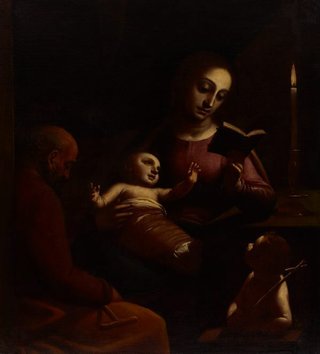
AGNSW collection Luca Cambiaso Holy Family with St John the Baptist circa 1578
Cambiaso was the leading artist in Genoa in the 16th century. A number of his later works are nocturnal scenes, where the figures are defined by flickering highlights from a single candle in an otherwise shadowy setting. He painted several variants of the Holy Family in this manner. It would be almost another half century before the idea caught on among Caravaggio and his northern followers, such as Gerrit van Honthorst and Georges de la Tour.

AGNSW collection Giulio Cesare Procaccini The dead Christ on the cross with Saints Mary Magdalene, Augustine and Jerome, and angels circa 1618
Procaccini was one of the leading painters active in Lombardy in the early 17th century. He was based in Milan, but also worked in Genoa where the wealthy banker Gian Carlo Doria was an enthusiastic patron. This altarpiece was painted for Doria. The painting is not a narrative. Rather the dead body of Christ on the cross – the Corpus Christi – is offered as an object for devotion in relation to the sacrament of the Eucharist which would have taken place at the altar below.
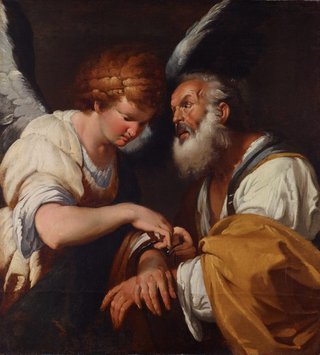
AGNSW collection Bernardo Strozzi The release of Saint Peter circa 1635
Strozzi began his career in Genoa (where he was much influenced by Giulio Cesare Procaccini) and from 1630 worked in Venice. This work depicts the apostle St Peter miraculously released by an angel from the prison in which he had been incarcerated by King Herod prior to his intended execution. The highly focused composition, vigorous application of paint and unidealised facial types are typical of Strozzi’s robust manner.
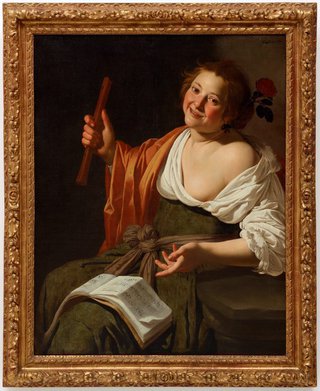
AGNSW collection Jan van Bijlert Girl with a flute circa 1630
This work belongs to a period after Van Bijlert’s return in 1624 to his native Utrecht after a stay in Rome, where in common with other Utrecht artists such as Gerrit van Honthorst and Hendrick ter Brugghen, he had been influenced by the work of Caravaggio. The picture had a pendant (present whereabouts unknown) of a cheerful young man tuning his lute. Music-making and musical accompaniment were frequently taken at the period as alluding to amorous activity.
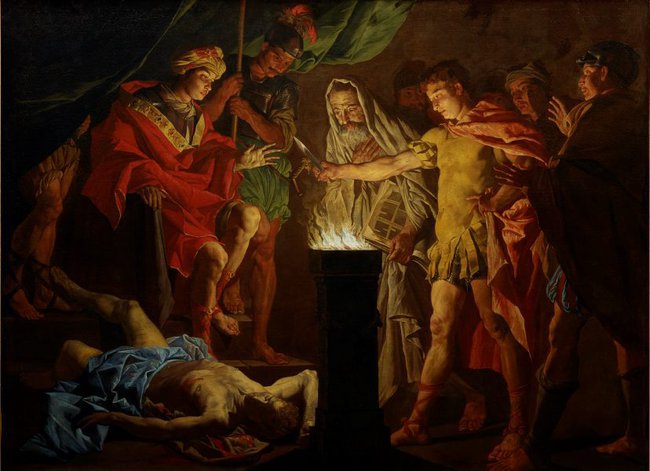
AGNSW collection Matthias Stomer Mucius Scaevola in the presence of Lars Porsenna early 1640s
Brought before the Etruscan king Lars Porsenna, the young Roman nobleman Mucius (who had just made an unsuccessful attempt on Porsenna’s life) thrust his hand into a flaming brazier, so impressing his captors by this display of fortitude that they liberated him and ultimately abandoned their siege of Rome. One of the Dutch artists who came under Caravaggio’s influence in Italy, Stomer painted a series of large historical subjects of this kind while he was in Sicily in the 1640s

AGNSW collection Frans Snyders The boar hunt circa 1650s
Snyders was a leading still-life and animal painter active in the Southern Netherlands in the 17th century. From the 1610s, he specialised increasingly in hunting scenes, of which The boar hunt is his last known hunting picture and a fine example of his late manner, which captures the drama of the kill. The artist elaborated the scene in two large canvases of which one, signed and dated 1653, is in the British Royal Collection at Hampton Court Palace.

AGNSW collection Johann Georg Platzer The sculptor's studio 1730
This bizarre picture is a characteristic example of the 18th-century Austrian painter Johann Georg Platzer, who made a speciality of minutely executed and highly detailed works painted on copper. The artist here imagines the scene as a well-heeled young woman visits the studio of a master sculptor. The artist sits enthroned among the activities of his pupils as he indicates the near completion of his last erotic masterpiece.
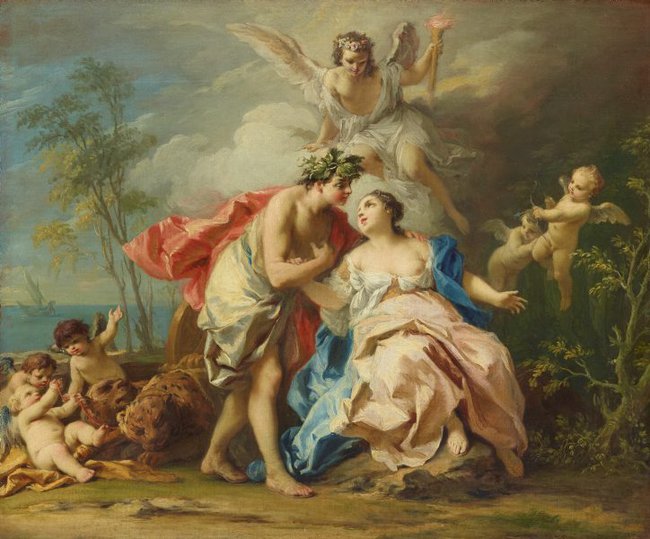
AGNSW collection Jacopo Amigoni Bacchus and Ariadne circa 1740-circa 1742
Abandoned by Theseus on the island of Naxos, Ariadne is discovered by the wine-god Bacchus, who falls in love with her and marries her. The winged figure in the clouds is Hymen, god of marriage. Theseus’s ship is in the distance. Amigoni painted a larger version for his friend, the great castrato opera singer, Farinelli. Our picture appears to be the prime version as it contains corrections (‘pentimenti’) to the line of Bacchus’s cloak, which have become visible with time.

AGNSW collection Nicolas de Largillierre Portrait of an officer circa 1714-circa 1715
Wearing a breastplate and sword, the man depicted clearly holds military office. The paper in his hand (with its broken red wax seal) could be a letter of appointment. The portrait is much smaller than is usual for the artist, but is not a sketch. It may be a repetition by Largillierre of a larger original, or possibly represents the artist’s response to the small, exquisitely finished portraits by Dutch painters then becoming fashionable in France.
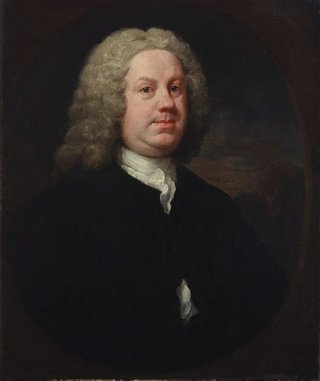
AGNSW collection William Hogarth Dr Benjamin Hoadly MD early 1740s
Benjamin Hoadly (1706–57), son of the Bishop of Winchester, was a medical doctor and dramatist. His popular comedy The suspicious husband was first performed at Covent Garden in 1747 with David Garrick in the lead role. He was a close friend of Hogarth whom he assisted in writing his quasi-scientific treatise on aesthetics, The analysis of beauty (1753). In character he was said to be ‘an amiable humane man and an agreeable sprightly companion’. The sobriety of this portrait – one of three portraits of the sitter by Hogarth – possibly reflects Hoadly’s appointment in 1742 as physician to the Royal household.

AGNSW collection Jean-Marc Nattier Madame de La Porte 1754
Madame de La Porte is a fine example of the exquisite court portrait style that ensured Nattier’s success at Versailles from around 1740, particularly as a painter of women. The artist handles paint with a softness that recalls the pastel portraits that were so much in vogue at the period. The sitter was once thought to be a comtesse, but seems rather to be masquerading as one; she has now been identified as the wife of the still-life painter Henri-Horace Roland de La Porte.
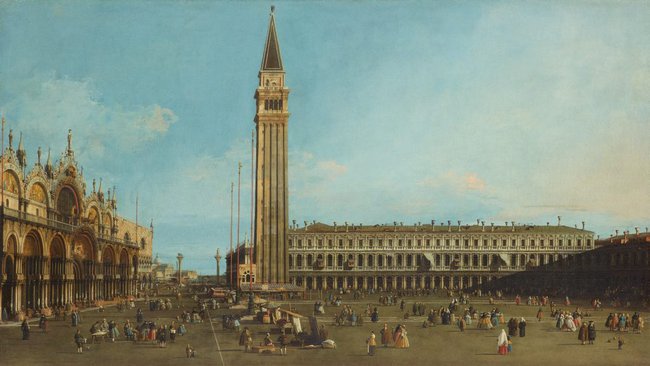
AGNSW collection Canaletto The Piazza San Marco, Venice 1742-1746
On the left is the basilica of St Mark’s. From left to right the scene also shows the Doge’s Palace, the distant church of San Giorgio Maggiore, the columns supporting the lion of St Mark and the statue of St Theodore, the Sansovino library in deep shadow, the Loggetta and Campanile and finally the Procuratie Nuove. Canaletto distorts the perspective radically in order to show all of these buildings as if from the same viewpoint.
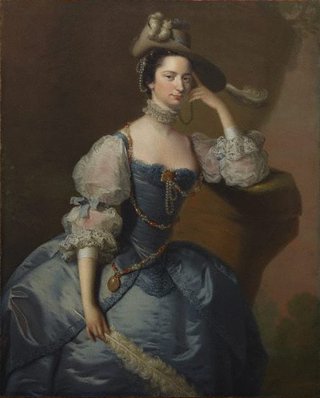
AGNSW collection Joseph Wright of Derby Margaret Oxenden circa 1757-circa 1759
Formerly attributed to Thomas Hudson, this canvas has recently been reattributed to Joseph Wright of Derby. It was probably painted during the period of Wright’s employment in Hudson’s studio in 1756–57 or very shortly afterwards. The costume is a type of fancy dress worn to masquerades known in the 18th century as ‘Van Dyck dress’, though in fact it is based on a portrait of Rubens’ second wife Helena Fourment (now in the British Museum). The same dress is repeated in several portraits by Hudson and Wright.

AGNSW collection Thomas Gainsborough Samuel Kilderbee circa 1758, partially repainted circa 1783
Samuel Kilderbee (1725–1813) was an Ipswich attorney who became a close friend of Gainsborough. The two men exchanged letters that are now lost, but which were described in the 19th century as ‘brilliantly eccentric and too licentious to be published’. A close examination reveals (and an X-ray confirms) that the portrait has been repainted in everything except the face. This perhaps occurred around 1783, as it was in that year that Kilderbee accompanied Gainsborough on a tour of the Lake District.
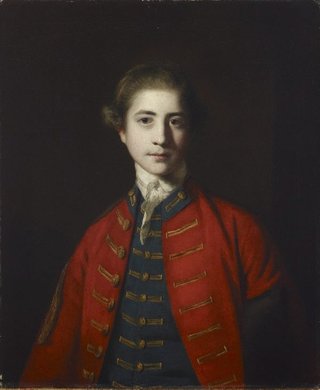
AGNSW collection Sir Joshua Reynolds Stephen Croft 1760
Stephen Croft, Junior (1744–1813) or Lieutenant Stephen Croft of Stillington (Yorkshire) was appointed in 1760 a cornet in the Royal North British Dragoons, known the Royal Scots Greys. The Scots Greys were stationed in Germany and the teenager was thus about to be separated from his family for some time. Like many of Reynolds’s portraits, this example suffers from the fading of a fugitive crimson pigment in the face which makes the sitter look rather sickly.

AGNSW collection Sir Joshua Reynolds James Maitland, 7th Earl of Lauderdale 1759-1760
The 41-year-old Lord Lauderdale (1718–89) had distinguished himself in the army, but was still young when he resigned and took a seat in the House of Lords (1747–61, 1782–84). He later also served as Lord of Police for Scotland and Rector of Glasgow University. Unequalled in his capacity for flattering portrayal, Reynolds shows a sophisticated young aristocrat leaning on the base of a Solomonic (twisted) column, suggestive of a trip to Italy the Scottish peer never in fact made.
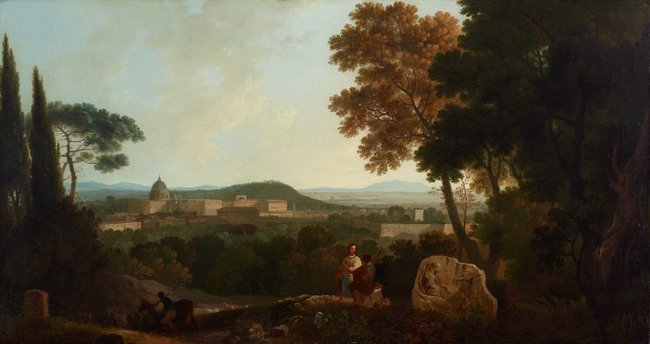
AGNSW collection Richard Wilson St Peter's and the Vatican from the Janiculum, Rome 1757-1764
The view is taken from a point on the Janiculum Hill. On the left are the buildings surrounding the Piazza San Pietro, while on the right the prospect of the Roman campagna extends to Monte Soratte. Wilson first painted this view while in Rome around 1753. Our version is a replica commissioned by the wealthy sugar plantation (and slave) owner William Young from Antigua (1725–88), who was then setting himself up as a country gentleman in Standlynch House, Wiltshire.

AGNSW collection Philippe Jacques de Loutherbourg A shipwreck off a rocky coast 1760s
This is one of De Loutherbourg’s finest shipwreck scenes painted in emulation of Claude-Joseph Vernet. It dates from the period of his hugely successful early Parisian career when his Salon exhibits were celebrated by the critic Denis Diderot. He became painter to the King at the age of 27 and a full member of the Academy at 30. The artist later moved to London and became the most inventive and influential stage designer of 18th-century Europe.

AGNSW collection Giovanni Domenico Tiepolo The apotheosis of a pope and martyr circa 1780-1785
This ceiling sketch shows the apotheosis of a pope. Angels hold his tiara (above) and his staff with a triple cross (below). The palm leaf held by one of the cherubs is a symbol of martyrdom, but the identity of this martyr-pope remains mysterious. The brown ground used to prepare the canvas is left uncovered around the edges. The picture still has a discoloured varnish and areas of restoration have become more apparent with age.

AGNSW collection William Hamilton Christ and the woman of Samaria 1792
At Jacob’s well Christ converses with a Samaritan woman: ‘whosoever drinks of [the well] water shall thirst again; but whosoever drinks of the water that I shall give him [ie Christian faith] shall never thirst; but the water that I shall give him shall be in him a well of water springing up into everlasting life’. The painting was commissioned by Thomas Macklin, an ambitious print seller established in London. The engraving made from it was used in an elaborate illustrated edition of the Bible which Macklin finally published in 1800.
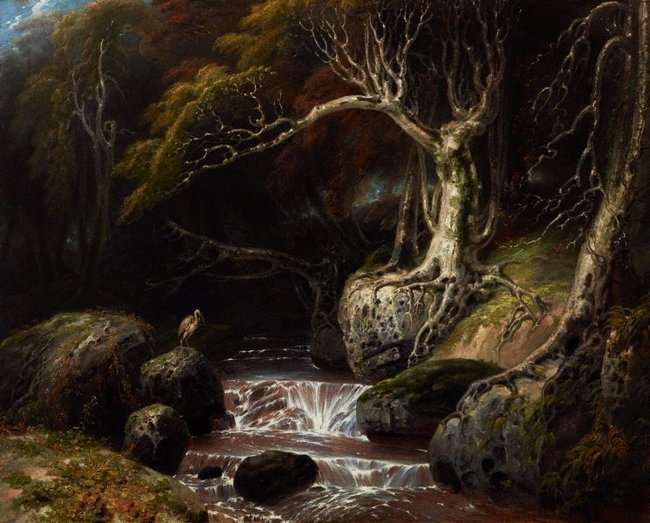
AGNSW collection Richard Westall Landscape – solitude 1811
The artist was brother to William Westall who was chosen, on the recommendation of the painter and Royal Academician Benjamin West, to accompany Matthew Flinders on his voyage to Australia in 1801. Though Richard remained in England he brought a certain savagery to romantic visions of landscape such as this. The title refers to a line from the proto-romantic Scottish poet James Thomson (1700–48): ‘Along these lonely regions, where retir’d / From little scenes of art, great nature dwells / In awful solitude’.

AGNSW collection John Glover Ullswater, early morning circa 1824
This is an exceptional example of the idealised landscapes painted by Glover before his emigration to Australia in 1830. While the foreground is invented, the background is a faithful rendering of one of the artist’s favourite subjects – the Cumbrian lake of Ullswater where he had purchased a small farmhouse in around 1815. When Glover settled in Tasmania he named his new home Patterdale in memory of the small village which stands at the end of Lake Ullswater.
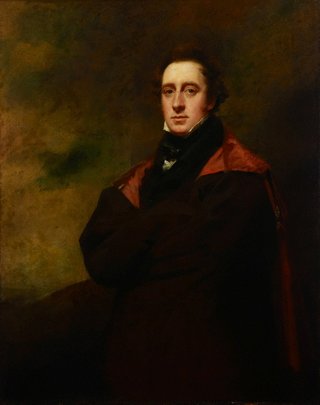
AGNSW collection Sir Henry Raeburn John Spottiswoode of Spottiswoode circa 1820
Raeburn’s portraits evoke a romance that lies at the heart of the 19th-century image of Scottishness. Hence the figure of Spottiswoode (1780–1866) is seen from a low viewpoint against a brooding, stormy sky. Yet this was a man of pragmatic enlightenment; his achievements ranged from the publishing of the ancient charters of Dryburgh Abbey to breeding the largest ox ever recorded. His literary inclinations were shared by his brothers who ran the publishing firm that became Eyre & Spottiswoode.

AGNSW collection Sir Charles Lock Eastlake An antique rural scene 1823-1824
Painted for Horatio Walpole, 3rd Earl of Orford, this picture was exhibited in London in 1824 under the title An antique rural scene. The catalogue adds a quotation from the great pastoral poet Theocritus: ‘Daphnis on his reed shall play...’ Eastlake is best remembered as a writer on art and for his achievements as director of the London National Gallery from 1855, where he was responsible for the purchase of many of the gallery’s Italian Renaissance masterpieces.
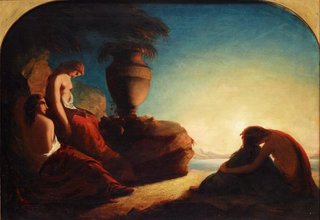
AGNSW collection Francis Danby The three sisters of Phaethon weeping over the tomb of their brother 1841-1845
Danby was mainly a painter of poetical fantasy landscapes inspired by the works of Claude Lorrain and JMW Turner. The story of Phaethon is told in the second book of Ovid’s Metamorphoses. Promised any boon by his father Apollo, Phaethon asked to drive the sun chariot for a day, but unable to control it fell to his death. His sisters, the Heliades sought out his tomb and mourned his death for many days, until they found themselves rooted to the ground and transformed into poplar trees.

AGNSW collection David Roberts Edinburgh from the Calton Hill 1858
Though better known for more exotic subject matter, in particular topographical views made in the Near East, Roberts remained deeply attached to, and highly regarded in, his native Scotland. In this ambitious and faithful view overlooking the whole of Edinburgh, prominent landmarks include the Burns Monument in the right foreground and the gothic revival spire of the Scott Monument. In the middle ground we can glimpse the classical facade of William Henry Playfair’s newly built National Gallery.